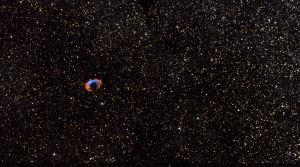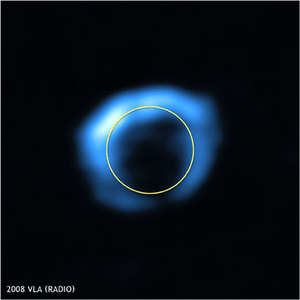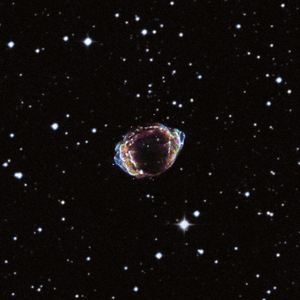Blog
Remnant
17 March 2014
 X-ray (NASA/CXC/NCSU/S.Reynolds et al.); Radio (NSF/NRAO/VLA/Cambridge/D.Green et al.); Infrared (2MASS/UMass/IPAC-Caltech/NASA/NSF/CfA/E.Bressert)
X-ray (NASA/CXC/NCSU/S.Reynolds et al.); Radio (NSF/NRAO/VLA/Cambridge/D.Green et al.); Infrared (2MASS/UMass/IPAC-Caltech/NASA/NSF/CfA/E.Bressert)In the constellation Sagittarius is a small, dim supernova remnant known as G1.9+0.3. It was first discovered in 1984 by the VLA radio telescope. It was found to be about 28,000 light years away, and was likely a Type Ia supernova, which are used as standard candles for measuring galactic distances. Given its apparent size, it was thought to be the remnant of a relatively young supernova, perhaps in the last 1,000 years or so. But then in 2008 it was observed again, and we discovered something extraordinary.
 NSF/NRAO/VLA/Cambridge/D.Green et al
NSF/NRAO/VLA/Cambridge/D.Green et alYou can see this in the image at right. It compares the remnant as observed in both 1984 and 2008, and you can see how the remnant is grown over the course of 24 years. The change might not look like much, but it is actually huge. It was found to be about 15% larger in 2008 than 1984. Such an increase of size in such a short time means the supernova progenitor must have occurred about 100 years ago. Which is interesting, given that the last supernova observed in our galaxy was the Kepler supernova of 1604.
 NSF/NRAO/VLA/Cambridge/D.Green et al
NSF/NRAO/VLA/Cambridge/D.Green et alA supernova such as this one can shine as bright as an entire galaxy. The 1604 supernova was easily visible with the naked eye, and was noted to be brighter than all the planets other than Venus, and it was roughly the same distance away as G1.9+0.3. So how is it that a mere century ago astronomers missed a supernova right in our back yard?
It all has to do with location. Kepler’s supernova was in the constellation Ophiuchus, in a direction which is relatively free of dust. G1.9+0.3 on the other hand is located near the center of our galaxy, which is very obscured by dust. This meant that most of the light from the visible spectrum is obscured. It’s not surprising then that the supernova went unseen.
In many ways this supernova remnant is a testament to the tremendous advances we’ve made in astronomy. A century ago our best astronomers didn’t even notice this supernova. Now we can observe its remnant by peering through the dust with radio and x-ray telescopes. We’ve come a long way in 100 years.
Thanks to Peter Edmonds for inspiring this post.